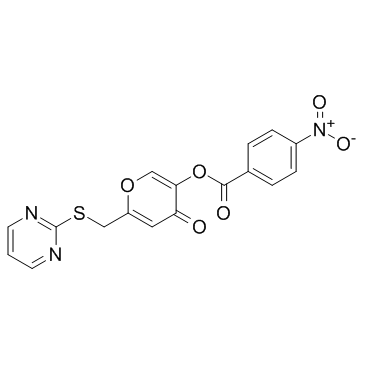| Description |
ML221 is a potent apelin (APJ) functional antagonist, inhibiting apelin-13-mediated activation of APJ, with IC50s of 0.70 μM in the cAMP assay, and 1.75 μM in the β-arrestin assay, and EC80 of 10 nM in both assays.
|
| Related Catalog |
|
| Target |
IC50: 1.75 μM (APJ, cell-based)[1]
|
| In Vitro |
ML221 is a potent apelin/APJ functional antagonist, inhibiting apelin-13-mediated activation of APJ, with IC50s of 0.70 μM in the cAMP assay, and 1.75 μM in the β-arrestin assay, and EC80 of 10 nM in both assays. ML221 is >37-fold selective over the closely related angiotensin II type 1 (AT1) receptor (IC50, >79 μM) in cells. ML221 displays limited cross reactivity against a range of GPCRs except the κ-opioid and benzodiazepinone receptors (<50/<70%I at 10 μM)[1].
|
| Cell Assay |
Cells (angiotensin II receptor-like 1 (AGTRL-1) cell line) are seeded at 1000 cell/well (1536 plate) in 4 μL and grown overnight (16-18 h) at 37°C, 5% CO2, 100% humidity, then 60 nL of either DMSO control or 2 mM stock test compounds (ML221, etc.) in DMSO are transferred to each well, followed by 2 μL of 30 nM Apelin-13 to negative control and test compound wells, and 2 μL of assay media (F12 nutrient mix HAMs supplemented with 10% hi-FBS, 1× penicillin/streptomycin) to positive control wells. This yields a final concentration of test compound (ML221, etc.) of 20 μM and 1% final DMSO. Assay is incubated for 90 min at room temperature, and then developed with 3 μL of detection reagent for 60 min and luminescence read on a ViewLux[1].
|
| References |
[1]. Maloney PR, et al. Discovery of 4-oxo-6-((pyrimidin-2-ylthio)methyl)-4H-pyran-3-yl 4-nitrobenzoate (ML221) as a functional antagonist of the apelin (APJ) receptor. Bioorg Med Chem Lett. 2012 Nov 1;22(21):6656-60.
|
